The engine lubrication system is combined: the most loaded parts are lubricated under pressure, and the rest are lubricated either by directed spraying or spraying of oil flowing from the gaps between mating parts
The lubrication system is pressurized by a gear oil pump mounted externally at the front of the cylinder block and driven by a chain from the crankshaft.
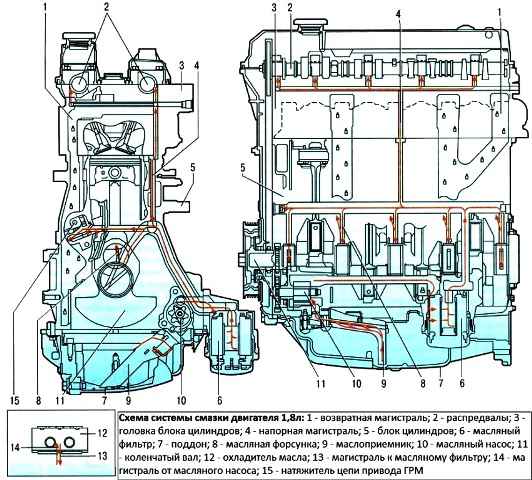
The pump sucks oil from the engine oil sump through the oil receiver and delivers it through a full-flow oil filter with a porous paper filter element to the main oil line located in the body of the cylinder block.
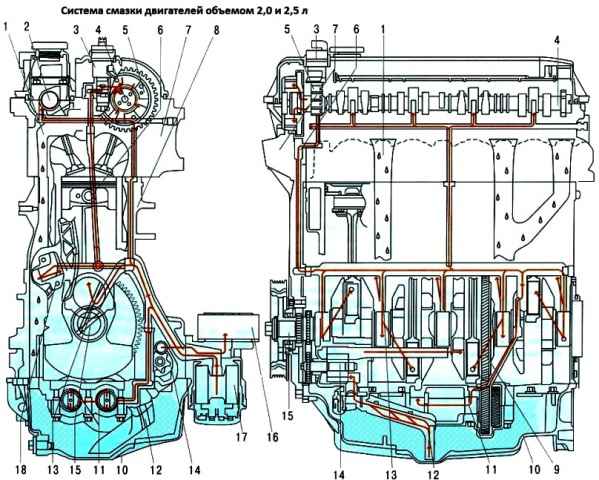
1 - return line; 2 – a camshaft of final valves; 3 - electromagnetic valve of the phase regulator; 4 – a camshaft of final valves; 5 - the mechanism of the phase regulator of the intake camshaft; 6 - main oil line; 7 - cylinder head; 8 - cylinder block; 9 - drive gear for balancing shafts (engines 2.5 l); 10 - oil sump; 11 - balancing shafts (engines 2.5 l); 12 - oil receiver; 13 - oil nozzle; 14 - oil pump; 15 - crankshaft; 16 - oil cooler; 17 - oil filter; 18 - timing chain tensioner
The oil supply channels to the main bearings of the crankshaft depart from the main line
Oil is supplied to the connecting rod bearings through channels made in the body of the crankshaft, and then sprayed onto the cylinder walls and piston bottoms by oil nozzles.
To lubricate the camshaft bearings, oil from the vertical channel enters the camshaft channels through a radial hole in the bearing journals and is distributed over them.
The camshaft cams are lubricated with oil coming from the central axial channels through the radial holes in the cams
Excess oil is drained from the cylinder head into the oil sump through vertical drain channels
Oil jets installed in the cylinder block and aimed at the piston bottoms serve to cool the pistons by splashing oil
The oil pressure in the engine lubrication system acts on the ball valve in the oil nozzle, opens and closes the oil channel in the nozzle, controlling the start and stop of the oil supply.
A feature of the lubrication system for engines with a working volume of 2.0 and 2.5 liters is the presence of a variable valve timing system, in the hydraulic system of which oil is supplied from the main oil line 6 (Fig. 2) of the engine.
Solenoid valve 3, at the signals of the engine control unit, supplies oil to the working cavities of the variable valve timing mechanism, or drains oil from these cavities
Possible malfunctions of the lubrication system and methods of elimination
Insufficient oil pressure in a warm engine
- using the wrong brand of oil
Change the recommended oil
- dilution or foaming of the oil due to the penetration of fuel or coolant into the oil sump
Remove causes of fuel or coolant intrusion. Change oil
- pollution of the working cavity or wear of the oil pump
Flush or repair the oil pump
- clogged oil filter
Change the oil filter
- loosening or clogging of the oil receiver
Fix the oil receiver, wash its filter
- increased clearance between the main or connecting rod bearing shells and the crankshaft journals
Sand the necks and replace the liners
- cracks, pores in the walls of the oil channels of the cylinder block or clogging of the oil lines
Repair the cylinder block. If it is impossible to eliminate the defect, replace the block
- loose installation of oil channel plugs or their absence
Restore the tightness of the plugs, install the missing plugs
Increased oil consumption
- oil leakage through the engine seals
Tighten fasteners or replace gaskets and seals
- the crankcase ventilation system is clogged
Clean the parts of the crankcase ventilation system
- wear of piston rings or engine cylinders
Rebore cylinders and replace pistons and rings
- breakage of piston rings
Replace rings
- coking of oil scraper rings or grooves in piston grooves
Clean the rings and grooves from soot, change the engine oil
- wear or damage to valve stem seals
Replace oil seals
- increased wear of valve stems or guide bushings
Replace valves, repair cylinder head
Changing engine oil and oil filter
According to the manufacturer's recommendation, the engine oil should be changed after 1 year of operation or 15 thousand kilometers (whichever comes first).
In severe operating conditions in a large city or very dusty area, change the oil and filter every 10,000 km.
The manufacturer recommends using ACEA VZ, API SJ oil of SAE 10W-40 or 5W-30 viscosity grade (depending on climatic conditions).
You will need: engine oil, an oil filter, a clean rag, a container (at least 5 liters) for draining oil, a “17” key, a special key for unscrewing the oil filter.
Drain the oil after driving, while the engine is still warm
If the engine is cold, start it and warm it up to operating temperature
Pour in the same brand of oil as the oil that was in the engine
If you still decide to change the brand or type of oil, flush the lubrication system with flushing oil or oil of the brand that will be used.
To do this, after draining the old oil, fill in new oil to the lower hole of the dipstick
Start the engine and let it idle for 10 minutes
Drain the oil before changing the oil filter.
Now you can fill in new oil to the required level (up to the top hole on the dipstick).
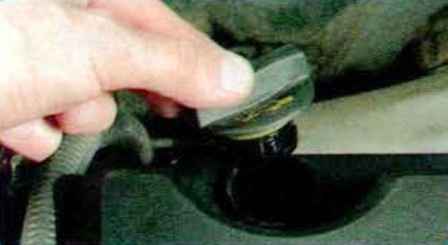
Unscrew the oil filler cap
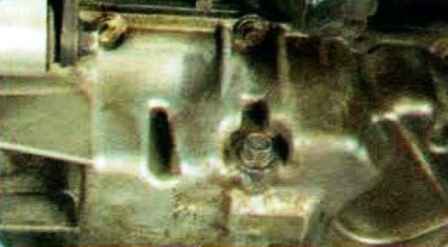
We clean the drain plug of the engine oil crankcase with a metal brush, and then with a rag
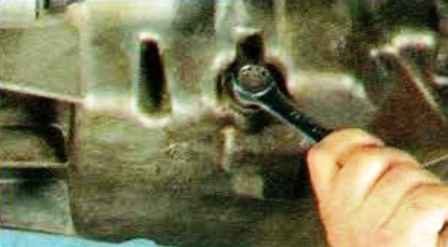
Loosen the drain plug, unscrew the plug, substituting a container to drain the oil, and drain the oil
Tightening the cork

We move the oil filter with a special wrench and, turning it off by hand, remove the filter

Wipe the mating surface of the cylinder block flange
Fill the new filter a third of the volume with clean engine oil
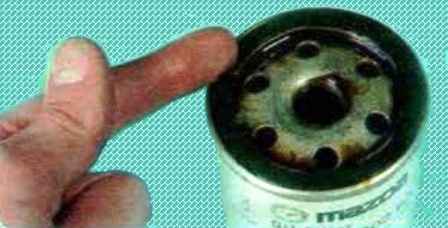
Lubricate the filter O-ring with oil
We put the filter in place and twist it by hand 3/4 of a turn from the moment the sealing ring and the flange of the cylinder block come into contact
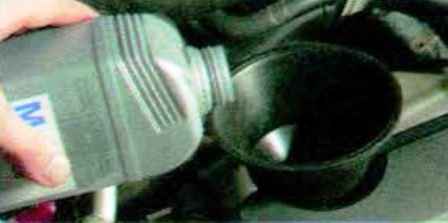
Pour clean engine oil into the engine
After 3-5 minutes, take out the oil level indicator (dipstick), wipe it with a rag and put it back in place
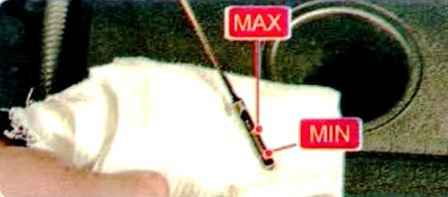
Re-remove the dipstick
The oil film level must be between the MIN and Max marks
If the oil level is below or near the MIN mark, add oil
After the oil level reaches the required level, tighten the filler cap
Start the engine and let it idle for a few minutes (the emergency oil pressure warning light should go out two to three seconds after starting the engine)
During operation, we check the tightness of the connections
Stop the engine and check the oil level, top up if necessary





